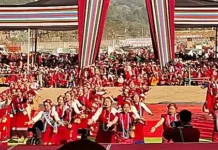[ Persis Farooqy ]
“Heritage” in the broadest sense is that which is inherited. Everything which our ancestors bequeath upon us is called heritage: landscapes, structures, objects, traditions, artefacts and language. Heritage is our legacy from the past, what we live with in the present, and what we pass on to future generations. They are our touchstones, our points of reference, our identity. The 1972 UNESCO Convention concerning the Protection of the World Cultural and Natural Heritage was established to safeguard cultural and natural heritage of outstanding universal value for future generations. World Heritage sites belong to all the peoples of the world, irrespective of the territory on which they are located. These sites reflects the wealth and diversity of the Earth’s cultural and natural heritage. The purpose of the Convention is to ensure the identification, protection, conservation, presentation and transmission to future generations of the cultural and natural heritage of ‘outstanding universal value’. Currently UNESCO World Heritage Convention has 167 States Parties with 1121 properties have been inscribed on the World Heritage List, including 869 cultural sites, 213 natural sites and 39 mixed sites.
Arunachal Pradesh has unique and diverse cultural heritage providing an ideal landscape. It is known to be one of the magnificent multilingual tribal areas of the world. The state represents an assemblage of natural as well as cultural heritage practiced over generations. To recognise, document and conserve this heritage legacy of the state, Arunachal Pradesh Heritage Authority (APHA) was constituted in 2019. Recently, the first meeting of APHA took place to discuss the prospects of World Heritage Sites in the state. Though there are 3 sites from Arunachal Pradesh listed on India’s tentative of World Heritage Sites, none of them have got the formal designation yet. These sites are Thembang Fortified Village in West Kameng as Cultural Site, Apatani Cultural Landscape in Lower Subansiri as Cultural Landscape since 2014 and Namdapha National Park in Changlang district as Natural Site since 2006.
According to the mandate of UNESCO, all countries submit their Tentative Lists of places which they consider to be a cultural or natural heritage of Outstanding Universal Value and therefore suitable for inscription on the World Heritage List. It is an important step since the World Heritage Committee cannot consider a nomination for inscription on the World Heritage List unless the property has already been included on the State Party’s Tentative List.
World Heritage tags are often perceived as imposition of restrictions and delineation of rights of the locals. It is agreed that restrictions do come along with international designations, but these restrictions are only limited to the boundary of the designated property, not the entire landscape. Hence it is at the jurisdiction of the State government with local stakeholders to demarcate the boundaries of the property. Besides, when there is some kind of vandalism, destruction or alteration at the World Heritage Site — built heritage or natural — from the time it was inscribed, UNESCO takes cognizance and sends a letter to the party concerned. The idea is to maintain integrity and authenticity of the property. Arunachal Pradesh being a state with variety of cultural diversity, World Heritage can be used as a tool to safeguard local heritage, along with an international tag.
One of the key benefits of the World Heritage status is that it will bring Arunachalee culture on the global map giving a fillip to tourism of the state. These sites will get greater appreciation all over the world for its uniqueness as compared to other sites. When tourism is well planned for and organized respecting sustainable tourism principles, they can bring important funds to the site and to the local economy. These attractions will bring economic benefit through creation of jobs and boost the local economy through wealth creation along with preservation of tangible and intangible heritage.
The World Heritage concept is so well understood that sites on the List are a magnet for international cooperation and may thus receive financial assistance for heritage conservation projects from various sources. Regarding financial assistance, this tag brings access to the World Heritage Fund. This fund is provided under three categories – Preparatory assistance i.e. helps with the preparation of inventories of potential World Heritage sites (Tentative Lists), of nominations to the World Heritage List, and of requests for technical cooperation, including training courses; Emergency assistance i.e. provided to sites in imminent danger due to severe damage from sudden event and Conservation and management assistance i.e. allocated for a number of disciplines relevant to the monitoring, conservation and management of World Heritage.
Lastly, we know that the best to safeguard world cultural and natural heritage is for societies to care enough about it to mobilize to protect it and support governments and specialised groups in working towards its conservation. New thinking is needed to open new imagination avenues in caring for world heritage properties. Success in conserving the masterpieces of God’s and human’s creative genius will depend on our ability to interact, negotiate and cultivate heritage as a creative process. (The contributor is AP CM Fellow. The views stated above are personal.)




